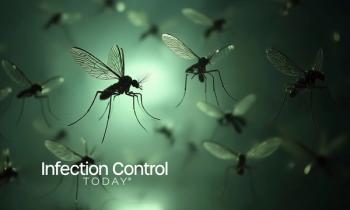
Pneumonia Bacterium Leaves Tiny Lesions in the Heart, Study Finds
The long-observed association between pneumonia and heart failure now has more physical evidence, thanks to research in the School of Medicine at the University of Texas Health Science Center at San Antonio.
The long-observed association between pneumonia and heart failure now has more physical evidence, thanks to research in the School of Medicine at the University of Texas Health Science Center at San Antonio. The researchers found proof that Streptococcus pneumoniae, the leading cause of community-acquired pneumonia, actually physically damages the heart. The bacterium leaves tiny lesions that researchers detected in mouse, rhesus macaque and human autopsy tissue samples. This image from a mouse heart shows a cardiac micro-lesion, seen at right, next to a blood vessel, left. Image courtesy of Dr. Carlos Orihuela, UT Health Science Center at San Antonio
The long-observed association between pneumonia and heart failure now has more physical evidence, thanks to research in the School of Medicine at The University of Texas Health Science Center at San Antonio. The researchers found proof that Streptococcus pneumoniae, the leading cause of community-acquired pneumonia, actually physically damages the heart. The bacterium leaves tiny lesions that researchers detected in mouse, rhesus macaque and human autopsy tissue samples.
"If you have had severe pneumonia, this finding suggests your heart might be permanently scarred," says study senior author Carlos Orihuela, PhD, associate professor of microbiology and immunology at the UT Health Science Center San Antonio.
It's not yet known whether the small lesions contribute to increased risk of death in humans or if the scarring that occurs afterward is permanent, ultimately diminishing cardiac function in individuals who have recovered from a severe infectious disease episode. The team will study the long-term ramifications in non-human primates at the Texas Biomedical Research Institute's Southwest National Primate Research Center.
Streptococcus pneumoniae in the blood invaded the heart and formed lesions in the myocardium, the muscular middle layer of the heart wall, the researchers showed. The team identified mechanisms by which the bacterium is able to spread across endothelial cells in cardiac blood vessels to travel to and infect the heart.
"Fortunately, we have a candidate vaccine that can protect against this," Orihuela says. The Health Science Center, St. Jude's Children's Research Hospital in Memphis, Tenn., and the University of Oklahoma have claimed intellectual property protection on the vaccine project. The candidate vaccine acts to stop both the movement of the infection into the heart and the toxin that kills heart muscle cells called cardiomyocytes. The vaccine protected immunized animals against cardiac lesion formation, the study showed.
Study limitations included the small sample size of human tissues analyzed, the researchers noted. The American Heart Association and the National Institutes of Health funded the project. The journal PLoS Pathogen published the study online Sept. 18.
Armand Brown, a Translational Science Training Scholar studying for his PhD at the Health Science Center, is lead author. Other co-authors from the Health Science Center include Marcus Restrepo, MD, of the Division of Pulmonary Diseases and Critical Care Medicine and the South Texas Veterans Health Care System; Martha Hanes, DVM, of the Department of Laboratory Animal Resources; and Claude Jourdan Le Saux, PhD, of the Janey and Dolph Briscoe Division of Cardiology in the School of Medicine.
Source: University of Texas Health Science Center at San Antonio
Newsletter
Stay prepared and protected with Infection Control Today's newsletter, delivering essential updates, best practices, and expert insights for infection preventionists.





